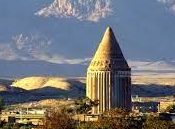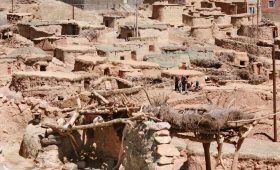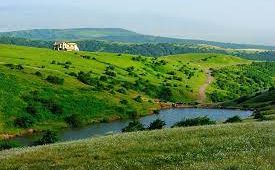Radkan Tower is one of the historical and architectural attractions and places of interest of Mashhad, that many have visited and passed by, and some have paid attention to it and had special impressions of it. Having astronomical and architectural information when visiting historical attractions makes us have a better judgment about these works. Radkan Tower is one of the famous places of Razavi Khorasan and is located in Chenaran.
The height of Radkan Tower is about 25 meters. This tower has a cylindrical body and its dome is cone-shaped. This historical work has been considered to be related to the Ilkhanan period and the 7th century of Hijri. On January 15, 1310, Radkan Tower was registered as number 146 in the National Monuments of Iran. The exterior of this building is 12-sided up to a height of three meters, and then it has 36 cracks or semi-cylinders up to the bottom of the dome, and the interior is octagonal.
The builder of Radkan tower is considered to be Khwaja Nasiruddin Tusi, who built this tower based on astronomical data and with a special intention that will be mentioned with his knowledge and thinking. The construction and design of this building is attributed to Khwaja Nasir al-Din Tosi, and there is no specific source that confirms it for sure. Some orientalists consider the history of the construction of this building to be a tomb from the works of the Daylami period and introduce it as the tomb of a woman named Teherir al-Shams.
Radkan Tower is about 36 meters high. The inner diameter of the building is 14 meters and its outer diameter is 20 meters. The exterior view of the building is made up to a height of 2.5 meters in the form of 12 sides and from there to the bottom of the dome in the form of 36 semi-column cracks. The Radkan tower has a conical dome. The construction date of this building was mentioned by Herzfeld in 680 BC. The date engraved on the inscription on the tower shows the year 660 AH, which is the same time as the completion of the construction of the buildings related to the Maragheh Observatory, as the construction date of the tower. Herzfeld considers the tower to be the tomb of one of the Mongol governors, whom some consider to be Amir Arghun of the Mongols. Meanwhile, some sources have mentioned Arghun’s tomb in Soltanieh.
This tower is founded with 12 external clay walls with width and height, which divide the tower into 12 sections of 30 degrees. Each wall covers 30 degrees of the horizon angle. Two doors are built on the opposite wall, and there are 365 reed columns on the wall that divide the tower into 36 10-degree cracks. The accuracy in choosing the location of the doors and vents in the tower shows that their installation was not accidental. This tower has twelve openings.
The body of the tower is made of simple bricks and has plaster decorations. For more strengthening, the distance between the bricks is compressed with finger pressure, which is significant. The entrance of the building, which is crescent-shaped, is on the south side of the dome. The most beautiful part of the building is its upper part, which consists of two Kufi and Pahlavi inscriptions, and it is located among the brickwork and plaster decorations on which the name of the founder and the date of construction are written. The interior design of the dome of Radkan is circular and has a simple appearance and is coated with plaster and lime. Plaster, lime and brick mortar are used throughout the building.
Some believe that the Radkan Tower was built for astronomical use in its day. Some also believe that the tower was a tomb. Due to the similarity of this tower with the tombs of the Dilamian era, some people have thought so. It is said that this tower has 12 openings and in its era it was considered the only means to determine the four seasons, leap year and Nowruz. Meanwhile, if we have a little historical information, we will realize that the Jalali calendar that we use today was invented and used by Khayyam in the Seljuk era, that is, several centuries before the Mongols. During the period of the Mughal patriarchs, calendar and astronomy topics were almost universal and had reached such a level of development that this tower could not be the only means of determining the four seasons or leaps. Rather, it can be said that this tower was perhaps one of the astronomical tools of that era.




